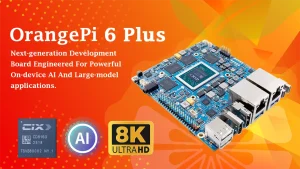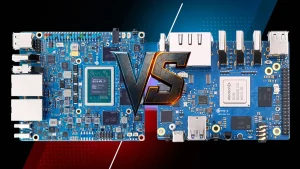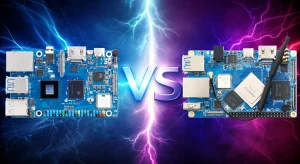
When exploring DIY electronics, Raspberry Pi vs Arduino is a common debate, especially for beginners. Both platforms offer exciting possibilities, but they cater to different needs due to their unique hardware and software capabilities. Arduino for Beginners is perfect for simple hardware projects like controlling LEDs and sensors, while Raspberry Pi for Beginners provides a full operating system for tasks like coding, web servers, and robotics. In this article, we’ll compare Raspberry Pi vs Arduino for Beginners to help you choose the right platform for your first project.
What is Raspberry Pi?
When discussing Raspberry Pi vs Arduino, it’s important to understand what sets Raspberry Pi apart. The Raspberry Pi is a compact, affordable single-board computer capable of running a full operating system, typically Linux-based. Designed for versatility, it’s perfect for a wide range of applications, from coding and automation to multimedia and robotics. Unlike Arduino for Beginners, which operates as a microcontroller for hardware control, Raspberry Pi for Beginners provides a complete computing environment, making it ideal for software development, web servers, and even AI-powered applications.
The latest Raspberry Pi 5 features a quad-core Arm Cortex-A76 processor running at 2.4GHz, with up to 8GB RAM, dual 4K HDMI output, and PCIe expansion, offering significant improvements over previous models. Older versions, like the Raspberry Pi 4, still deliver strong performance with a 1.5GHz quad-core CPU and USB 3.0 support. Additionally, all Raspberry Pi models include GPIO pins, enabling users to interact with external hardware like sensors, motors, and LEDs. This combination of computing power and hardware flexibility makes Raspberry Pi a hybrid solution for both software and electronics projects.
Key Features of Raspberry Pi
- Functions as a full-fledged computer with HDMI, USB, and networking capabilities.
- Runs Linux-based operating systems like Raspberry Pi OS.
- Handles complex tasks like multimedia playback, web browsing, and server hosting.
- Ideal for projects requiring computing power, networking, and advanced programming.
What is Arduino?
When comparing Raspberry Pi vs Arduino, it’s crucial to understand the unique strengths of Arduino. Arduino for Beginners is an open-source microcontroller platform designed for simple and efficient electronics projects. Unlike Raspberry Pi for Beginners, which runs a full operating system, Arduino operates without one, allowing it to execute tasks in real-time with minimal latency. This makes it perfect for controlling sensors, motors, LEDs, and other physical components in automation, robotics, and IoT applications.
Arduino boards, such as the widely used Arduino Uno, come with digital and analog input/output pins, enabling seamless integration with external hardware. Its lightweight nature and direct hardware control make it ideal for tasks that require precise timing and low power consumption. Additionally, Arduino’s strong open-source community provides extensive libraries, tutorials, and support, making it one of the best choices for beginners and hobbyists.
Whether you’re exploring Arduino vs Raspberry Pi for Beginners or selecting the right platform for your first DIY project, Arduino is an excellent choice for real-time electronics applications.
Key Features of Arduino
- Microcontroller-based, with no operating system.
- Simple programming via the Arduino IDE, using a beginner-friendly version of C++.
- Excellent for interacting with sensors, motors, and other hardware components.
- Perfect for small-scale projects like home automation and basic robotics.
4 Key Differences Between Raspberry Pi vs Arduino
Hardware
- Raspberry Pi: A complete computer with superior processing power, RAM, and storage, supporting peripherals like monitors, keyboards, and USB devices.
- Arduino: A simpler microcontroller with limited resources, tailored for direct interaction with electronic components.
Software
- Raspberry Pi: Runs Linux-based OSes, enabling multitasking and advanced applications like web servers and GUI-based tools.
- Arduino: Relies on straightforward code in the Arduino IDE, ideal for single-purpose control tasks without an operating system.
Programming
- Raspberry Pi: Supports multiple programming languages like Python, Java, and C++, offering flexibility for complex projects.
- Arduino: Focuses on a simplified version of C++ for faster and easier programming, especially for beginners.
See Program with Python for Electronics: Sensor Integration to IoT Guides
Projects
- Raspberry Pi: Best for projects involving multimedia, computing, and networking, such as media centers, game emulators, or IoT servers.
- Arduino: Excels in electronics-centric projects like basic robots, sensor monitoring, and small automation systems.
Which One Should You Choose?
For beginners, the choice depends on your project goals:
- If you’re focused on Arduino for Beginners, it’s an excellent option for learning basic electronics and programming. Its simplicity, affordability, and versatility in controlling hardware make it perfect for interactive projects like turning on LEDs or building simple robots.
- On the other hand, Raspberry Pi for Beginners is ideal for those looking to explore computing, multimedia, or networking. It’s a great choice for ambitious projects like creating a web server, programming with Python, or building a smart home system.
When deciding between Raspberry Pi vs Arduino, it ultimately depends on whether you need computing power or simple hardware control for your projects.
Conclusion: Raspberry Pi vs Arduino for Beginners
Both Raspberry Pi and Arduino are invaluable platforms for electronics enthusiasts, but choosing between them depends on your project needs and level of expertise. For those looking to build hardware-focused, simple automation systems, Arduino for Beginners is the clear winner due to its lightweight, real-time control capabilities. It’s perfect for controlling sensors, motors, and LEDs with ease.
However, when it comes to complex setups that require more computing power, Raspberry Pi vs Arduino sees Raspberry Pi come out on top. With the ability to run a full operating system and support advanced applications like web servers, multimedia, and AI, Raspberry Pi offers flexibility and power for more intricate projects.
Whether you start with Arduino for Beginners or dive deep into the Raspberry Pi vs Arduino debate, both platforms provide valuable learning experiences. Each has its strengths and offers exciting opportunities for anyone interested in electronics and programming.
By understanding their features and differences, you can confidently decide which platform best suits your next DIY endeavor.
Feel free to share your projects, ask questions, or provide feedback in the comments below.
See Arduino Projects and Raspberry Pi Innovations for 2025
FAQ
Which is better for beginners: Raspberry Pi or Arduino?
For beginners, Arduino is better for simple hardware-focused projects, while Raspberry Pi suits those exploring programming and computing.
Can Raspberry Pi and Arduino be used together?
Yes, Raspberry Pi and Arduino can complement each other, combining Raspberry Pi’s computing power with Arduino’s precise hardware control.
Related Articles:
- Latest Arduino Boards with Raspberry Pi Boards and Their Application Areas
- Arduino UNO R4 WiFi and SparkFun RedBoard Artemis: Which One is Right for You?






10 thoughts on “Which Is Better for Beginners, Raspberry Pi or Arduino? The Ultimate Comparison”
Pingback: Arduino UNO R4 WiFi vs. SparkFun RedBoard Artemis
Pingback: Top New Arduino Projects and Raspberry Pi Ideas for 2025
Pingback: Raspberry Pi 6 : New Features and What You Need to Know
Pingback: Program with Python: 4 Project Ideas for IoT and Electronics
Pingback: Best IoT Microcontrollers for 2025 Projects
Pingback: ESP32 vs ESP8266: 4 Key Differences for IoT Developers
Pingback: Top 5 ESP32 Alternatives That Won’t Break the Bank
Pingback: Arduino and Raspberry Pi: 3 Latest Boards & Uses
Pingback: Latest Arduino Boards 2025: Top 5 Products for IoT & Gadgets
Pingback: Best Open source Boards for IoT and Electronics 2025